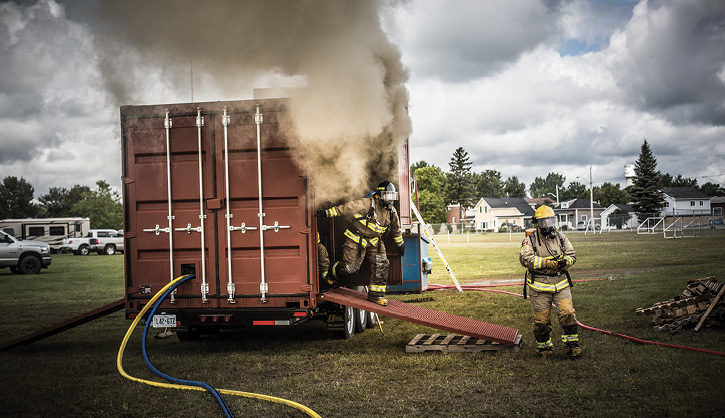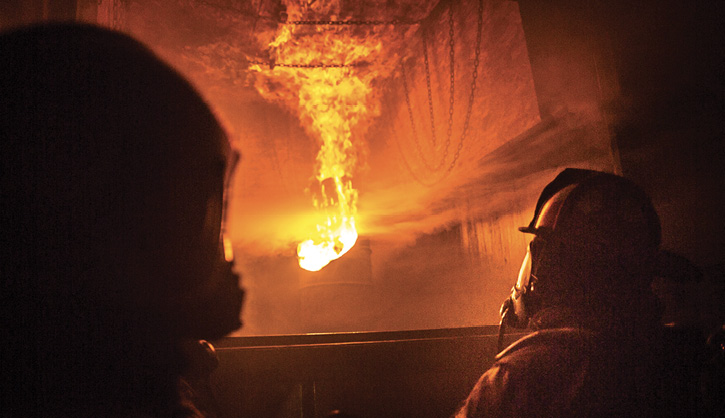
Live-Fire Training Michael Foster
In today’s economic environment, getting maximum value for your money is imperative. That’s why a lot of fire departments with a tight budget might be inclined to build their own training systems and props.
After all, when you take a simple look at some fire training systems, they just look like shipping containers placed together. Someone adds wood, sets it on fire, and there you go. Training is safely completed. But was it? Was it done safely? Or did we just get lucky again?
Should fire departments build their own fire training system rather than purchasing a fully designed and engineered structured?
Several issues arise when considering a training structure. First and foremost would be liability. We’re going to come back to liability, but let’s consider everything else.
- The Choice Between Class A and B for Training Systems
- Can’t Afford to Be Without It, But Can Your Department Afford a Fire Training System?
National Fire Protection Association (NFPA) 1402, Standard on Facilities for Fire Training and Associated Props, 2019 Edition, lists a variety of requirements to meet the standard; among them is engineered drawings of any training system.
Firefighter training systems require very specialized structural engineering. They are not like building normal structures since they will be repeatedly exposed to heat, fire, smoke, and much more. Understanding the impact requires an expert structural engineer who’s specifically aware of the stresses for fire training systems.

1 Although it looks like a shipping container, several engineering alterations are made for safe, predictable fire and smoke behavior. (Photos courtesy of Dräger.)
That structural engineering extends to elements one might not consider including the foundation and how the training system is secured. Just because someone knows a welder doesn’t mean the welds are structurally sound.
While from the outside a Swede system live fire training prop looks like an ordinary Class A shipping container, the interior has been significant altered to create fire environments that enhance firefighter training.
How to conduct the required educational components in these systems is outlined in the 2018 Edition of NFPA 1403, Standard on Live Fire Training Evolutions. Generating repeatable, safe evolutions that demonstrate recognizable fire and smoke behavior is paramount for an effective training program. Interiors must be properly engineered for ventilation that allows for the appropriate fire and smoke behavior to occur. For example, learning to recognize the fire and smoke behavior in an eventual flashover and ways to delay or mitigate it requires significant infrastructure in a training system.
Everything burns, and long-term exposure to the heat in metal structures can impact the integrity of the metal. Each training unit where a burn occurs is engineered with proper insulation to endure repeated exposures.
NFPA 1402 requires inspection every five years to certify that the interiors retain structural integrity for continued training. Additionally, every system includes instruction on what fuel to load, how much to create the desired training scenario, and resulting behavior of smoke and fire. Building your own system means a bit of trial and error on how much fuel is required. What happens when it’s too much?

2 Everything burns. Fire training systems are specifically engineered to endure the flames, heat, smoke, and other stresses of firefighting training.
This brings us to the inevitable question of liability. We all know firefighting is dangerous. Rookies and continuing education students should not be exposed to potentially unpredictable results. If a firefighter is injured while in a self-made training unit, liability could extend to the jurisdictions as well as individuals in the fire department. That means whoever built that unit—an individual, the chief, and other members of the fire department—could be subject to legal ramifications, both civil and criminal. Liability and the legal issues around using training systems that aren’t certified to NFPA standards are similar to those regarding other equipment like turnouts or self-contained breathing apparatus.
Yes, fire training systems are expensive, but making sure these systems are safe and properly engineered ultimately saves lives.
Michael Foster served at DFW International Airport for 25 years, retiring in 2015 as assistant chief of the DFW Fire Training Research Center. He then joined Dräger as senior product specialist for fire training systems. Prior to joining DFW, he served in the U.S. Air Force as a firefighter.

